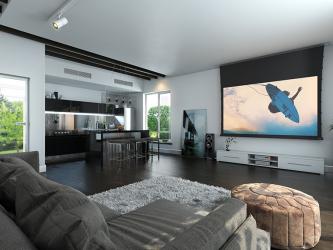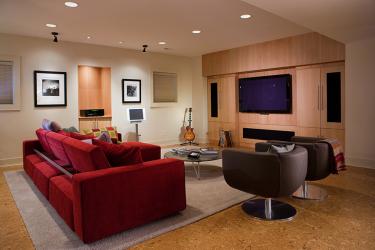Following World War II, the television set procured a place of honor in most American family rooms. The original cathode ray tube (CRT) set, though luxuriously expensive enough to warrant a prime location in any den, was an eyesore of protruding antennae and exposed wire. And though TVs have certainly become sleeker—and for some, sexier—since then, the same in-your-face nature of the things still plague those wanting the focal point of their interiors to be something besides a hulking square of plastic, wire and glass.
“Technology is always pushing forward and improving,” assures Aaron Walbrandt, of the eponymous Walbrandt Technologies in St. Louis. As more people rely on personal computers and cellphones for their moment-to-moment, day-to-day entertainment, some homeowners are upgrading their in-house systems to suit a more theater-style experience with ‘incognito entertainment.’
“It’s a totally different experience,” David Young of The Sound Room explains. With larger-than-life in-ceiling screens, 4K projectors and speakers that make the movie theater around the corner seem weak, the new home theater experience is entertainment without the décor blight, or the mysteriously sticky floors of the cinema. “Some people want the theater experience without having to dedicate a room in the basement solely for that purpose,” says Walbrandt. “With a well-placed, hidden drop-down screen, you put that theater experience where you will enjoy it the most.”…and free your mantel up for, you know, books and pictures of your family.
Aesthetics aside, both Walbrandt and Young agree there are other benefits to going incognito, such as keeping expensive electronics away from rambunctious children. “[Walbrandt Technologies] did an installation recently in an attic-turned-rec-room where the kids played pretty often.” The parents had considerably more peace of mind knowing that someone’s tiny head wasn’t going to annihilate a not-so-tiny entertainment investment.
“Even if you don’t go for the home theater,” says Young, “there are options like TV lifts and drop-downs that can hide your flat screen in the ceiling, or the floor. There’s even a system that (electronically) lowers a canvas over your screen, so your television is literally art when it isn’t being used.”
Like the latest-and-greatest TVs, a home theater setup requires a financial commitment. “The range in price can be staggering;” Walbrandt admits, “from a few thousand to several hundred thousand dollars. But going all out doesn’t mean you must take out a second mortgage. There are many products that produce fantastic results for a very reasonable price. But,” to understand the value, he adds, “it only takes watching one movie or the big game in 4K, on a 135” screen, with the Dolby Atmos surround sound.”
Furthermore, Young explains the new home theater simply as, “a sanctuary, a way to get away while never leaving your house.”
Though incognito entertainment may not seem ideal for every room, Young and Walbrandt explain that with controllable lighting and black-out shades, in-ceiling or in-wall speakers and sub-woofers embedded in the floor, it’s possible for virtually any room to become a home theater.
“People tell us they use it just as often as a traditional TV,” says Young of incognito theater options. “But it just isn’t like anything else out there. When you’re talking inches, you’re talking TV. When you’re talking FEET, now you’re talking home theater…and it all disappears at the push of a button.”
Resources
David Young, The Sound Room, 636-537-0404
Aaron Walbrandt, Walbrandt Technologies, 314-627-0346







